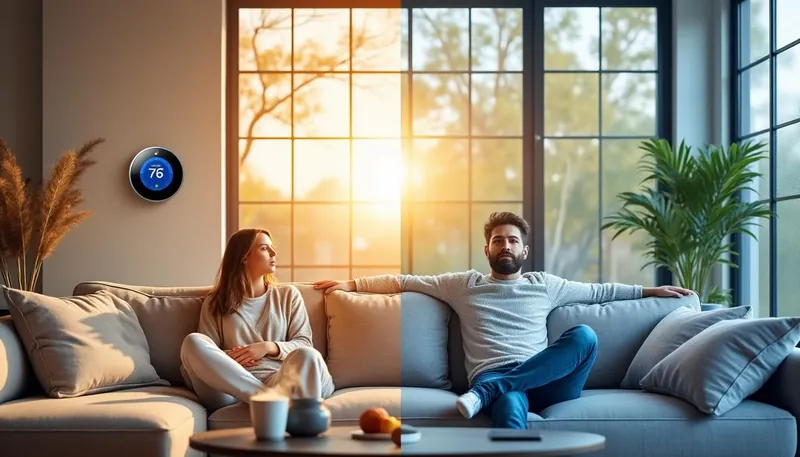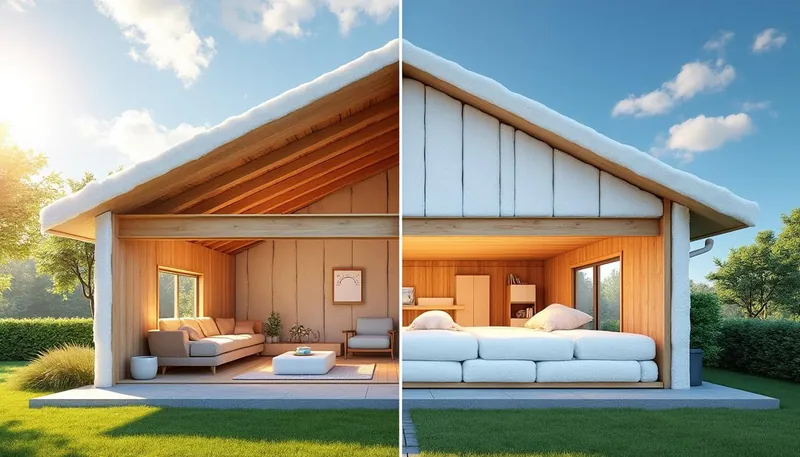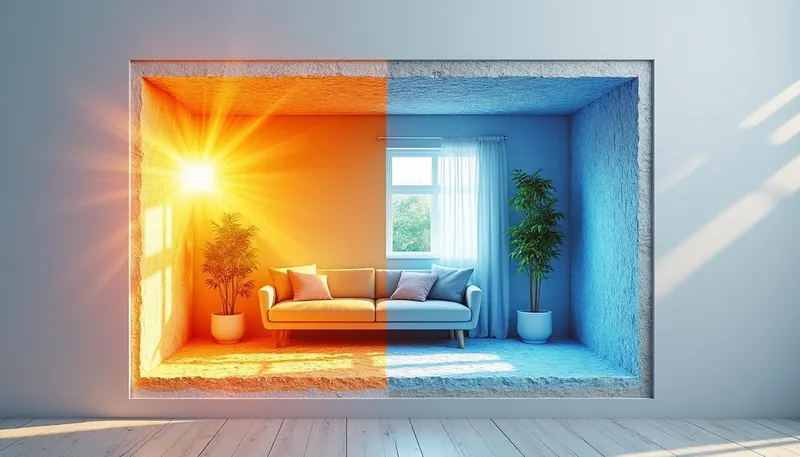Experiencing a comfortable and consistent indoor temperature can often feel like an elusive goal for homeowners. Whether you’re sweltering during the height of summer or shivering through winter, achieving a cozy climate year-round is vital not just for comfort but also for energy efficiency. So, what really influences indoor temperatures, and can you expect a noticeable difference after making changes like installing new insulation or upgrading your HVAC system? In this article, we’ll explore various factors affecting indoor climates, provide insights into effective solutions, and offer practical tips to enhance your home’s temperature management.
Brief
- Understanding temperature fluctuations in your home.
- The impact of insulation on indoor comfort.
- Simple fixes for improving temperature consistency.
- The importance of a well-designed HVAC system.
- Why energy audits are crucial for identifying issues.
The Dynamics of Indoor Temperature: Why Does It Change?
Many homeowners notice vast differences in temperature when moving from one room to another. It’s not uncommon for certain areas to feel much warmer or cooler than others, which can be incredibly frustrating. These temperature variations are caused by multiple factors within the home. First, it’s essential to understand how architecture plays a role. The construction, layout, and materials used in your home can significantly affect how temperature is maintained. For example, rooms that are poorly insulated are susceptible to heat loss in winter and heat gain in summer.
Architectural Factors That Influence Temperature
The design and size of your home impact heat distribution. An open floor plan might allow for better airflow and temperature equilibrium, while a multi-level home may experience differences between floors, with warmer air rising. As such, staircases might serve as thermal conduits allowing heat to travel up but neglecting to circulate cool air effectively.
Furthermore, the orientation of your home in relation to the sun is crucial. Rooms that face south typically receive more sunlight throughout the day, making them warmer than their north-facing counterparts. Homes with large windows may gain excess heat during the day, further exacerbating the problem. On the flip side, shaded areas, especially those with fewer windows, may remain cooler due to reduced sun exposure.
Insulation: A Key Factor in Indoor Temperature Regulation
One of the leading causes of temperature imbalances is inadequate insulation. Insulation acts as a barrier to resist heat flow, ensuring that warm air stays inside during the winter and reflects heat in the summer. If your insulation is damaged or insufficient, you’re likely to notice significant differences in room temperatures.
Types of Insulation:
- Fiberglass: Excellent for attics and walls.
- Foam Board: Provides a solid layer of insulation.
- Spray Foam: Ideal for irregular spaces.
- Cellulose: Made from recycled paper, it’s eco-friendly.
Even newer homes can suffer from poor insulation; it’s a misconception that all modern constructions are adequately insulated. Conducting a thorough inspection of your home and potential upgrades could lead to a more comfortable indoor climate.
Simple Fixes for Improving Temperature Consistency
While professional upgrades can yield significant benefits, some low-cost changes can help maintain a stable temperature throughout your home. These adjustments may be all you need to promote comfort without a significant investment.
Weatherstripping and Insulation
One of the simplest and most effective ways to keep conditioned air in and outside air out is to add weatherstripping around doors and windows. When done correctly, weatherstripping can help reduce drafts and improve your home’s overall temperature efficacy. Furthermore, sealing gaps around windows with caulk or foam sealant can often eliminate inefficient air exchange.
Window Coverings and Ventilation
Installing blackout curtains can block out unwanted heat from sunlight and keep rooms cooler during the summer. Conversely, in winter, these curtains can help maintain warmth when drawn. On the other hand, ensuring your home has adequate ventilation is crucial. A well-ventilated attic or basement assists in regulating indoor temperatures and reducing humidity levels.
Ceiling Fan Adjustments
Did you know that your ceiling fan works year-round? During summer, setting the fan to turn counterclockwise will create a cooling effect by pushing cool air down, while in winter, switch it to clockwise to circulate warm air that accumulates near the ceiling. Adjustments to the fan direction can make a marked difference in general comfort levels, maximizing your heating and cooling efforts without additional cost.
| Fixes | Impact on Temperature |
|---|---|
| Weatherstripping | Reduces drafts and keeps air inside |
| Blackout Curtains | Blocks unwanted heat |
| Ceiling Fan Rotation | Enhances air distribution |
| Sealing Windows | Prevents air leakage |
HVAC Systems: Ensuring Effective Temperature Management
If your temperature issue persists even with insulation and simple fixes, the next culprit might be your HVAC system. Each home has a unique requirement for heating and cooling, and your system needs to match that demand efficiently to maintain a stable climate.
Understanding Your HVAC System
First off, assess whether your HVAC unit is appropriately sized. An oversized system will cycle on and off too frequently, leading to inconsistent temperatures, while an undersized system will struggle to keep certain areas warm or cool, resulting in discomfort. The balance is key.
Another factor to consider is the design of your ductwork. If the ductwork is poorly designed, blocked, or leaking, it can hinder airflow, making it difficult for some rooms to receive adequate heating or cooling. Ensuring that your duct design is efficient is crucial for improving indoor temperatures.
Regular Maintenance is Essential
Keeping your HVAC system well-maintained can drastically improve its performance. Regularly replacing air filters can enhance airflow and, by extension, temperature regulation. A clean filter allows your HVAC system to run efficiently, providing consistent comfort as it should.
| HVAC System Issues | Effects on Temperature |
|---|---|
| Poorly Sized Units | Inconsistent temperatures |
| Dirty Air Filters | Restricted airflow |
| Leak in Ducts | Heat loss or gain |
| Blocked Vents | Reduced airflow |
The Importance of Home Energy Audits
Sometimes, even with appropriate insulation and an efficient HVAC system, inconsistencies can prevail. This is where a home energy audit becomes beneficial. An energy audit evaluates your home’s efficiency and can uncover hidden problems affecting indoor temperatures.
What to Expect from an Energy Audit
During an energy audit, professionals conduct a thorough inspection of your home’s insulation, ventilation, and HVAC systems. An auditor will use tools like thermal imaging cameras to identify temperature differences, pinpointing areas that need attention.
A blower door test can also be performed, measuring how well airtight your home is and identifying any leaks that may allow conditioned air to escape. The results can help determine whether you need air sealing, additional insulation, or ductwork repairs.
Having a Clear Roadmap for Improvements
Once the audit is complete, you’ll receive a detailed report outlining inefficient areas and recommendations for improvements. This insight can be invaluable for ensuring that your home remains consistently comfortable and energy-efficient. By addressing these issues, you can expect to see a noticeable difference in indoor temperature.
Will I notice an immediate difference after insulation installation?
Yes, most homeowners report a noticeable improvement in indoor temperature after adding insulation.
How often should I perform maintenance on my HVAC system?
Regular maintenance is recommended at least twice a year to ensure optimal performance.
What is a home energy audit?
A home energy audit assesses your home’s efficiency and identifies issues affecting indoor temperatures.
Can sealing gaps help save on energy bills?
Absolutely! Sealing gaps can significantly reduce energy loss and lower utility bills.
Is professional installation necessary for insulation?
While DIY is possible, professional installation ensures optimum effectiveness and safety.


